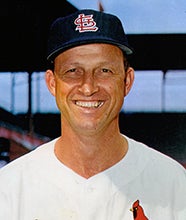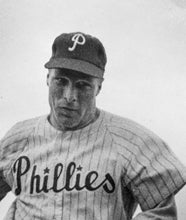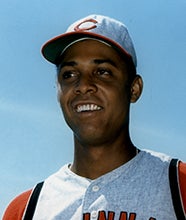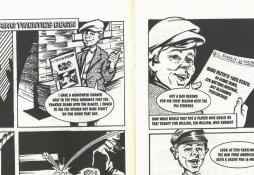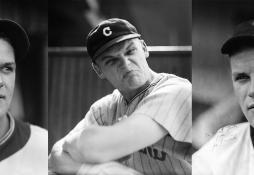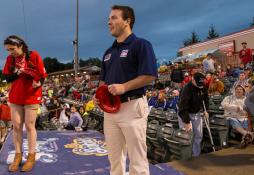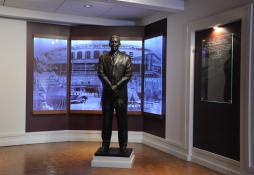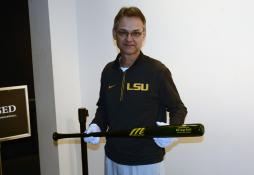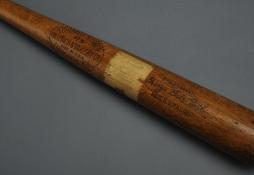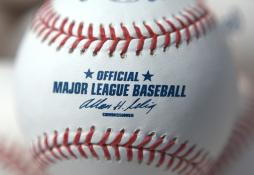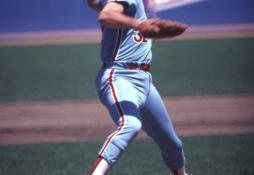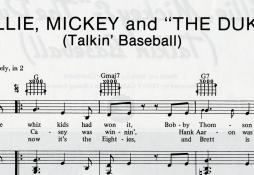I just can't believe my bats are here.
- Home
- Our Stories
- Taking his cut
Taking his cut
Baseball entrepreneur Jack Marucci swings through Cooperstown
About 13 years ago, LSU director of athletic training Jack Marucci bought a secondhand lathe and set to work in his tool shed to make a wooden bat for his son. On Friday evening, Marucci finally had the chance to see where several of his subsequent bats had ended up – within the hallowed walls of the Hall of Fame.
“I just wanted to see my bat on a Little League field to see my son play with it,” Marucci said. “There was no way you could even dream of seeing your bats come to a place like this.”
Marucci is here in Central New York with the LSU football team, who will play Syracuse on Saturday afternoon in the Carrier Dome. Marucci has served as the Tigers’ head athletic trainer for two decades now, but his most famous contributions have come on the baseball diamond as the founder of Marucci Sports.
Baseball players, much like any craftsmen, are particular about their tools. The only tool a player has at the plate is his bat, and it has to be perfect. The Hall of Fame collection houses bats from dozens of major leaguers and nearly all of them have a story to tell about their owners. Ted Williams, for instance, famously traveled to the Louisville Slugger lumber yard to pick out his own choice cut of wood, and could tell if a bat was even half an ounce too light or too heavy. Stan Musial scraped his bat handle down to be as thin as possible. Richie Ashburn slept with his bats on road trips.
So how was Marucci, who had no prior experience in woodworking before carving that first maple bat for his son, able to win over professional baseball players? It started with major league veteran Eduardo Perez, son of Hall of Famer Tony Perez, who was a friend of Marucci and tried out the bats as a favor. Eduardo quickly grew a liking to these new models and recommended them to slugger Albert Pujols, who started using them in batting practice, and future Hall of Famer Barry Larkin.
From there the word-of-mouth reputation of Marucci’s bats spread like wildfire. Today, Marucci Sports is the No. 1 bat manufacturer in the major leagues, with a 40 percent share of the market that surpasses even the ubiquitous Louisville Slugger. Among the players who use the Marucci line is a list of stars that could fill out an All-Star game roster; from veterans like Jose Bautista, Carlos Beltran and Andrew McCutchen to emerging superstars Kris Bryant, Josh Donaldson, Bryce Harper, Anthony Rizzo and Giancarlo Stanton.
Along with Brad Horn, Museum vice president of communications and education, Marucci took a trip down memory lane as he presented his bats that now reside in the Hall of Fame to fellow members of LSU’s traveling contingent. Adorned with Marucci’s script ‘M’ logo, the bats can be found all over the Museum, from a model used by Cuba in the 2006 World Baseball Classic to Edgar Renteria’s MVP-winning bat in the 2010 World Series to a club used by David Ortiz in the 2013 ALCS during the Red Sox’ “Boston Strong” run.
“The thing that we’re proud of is that we’re working with good people,” Marucci said of his superstar endorsers.
And those stars have taken a liking to Marucci in large part because of his attention to detail. Marucci relayed a story about one of his earliest adopters, slugger Carlos Beltran, which surprised him.
LSU athletic trainer and Marucci Sports founder Jack Marucci gave a presentation with Brad Horn, Museum vice president of communications and education, Friday evening on the stories behind several Marucci bats that have been donated to the Hall of Fame after various achievements. (Matt Kelly / National Baseball Hall of Fame)
“Carlos ordered six bats from us and we sent him five,” Marucci recalled. “He called us to ask why he hadn’t gotten the full six he ordered, and I told him it was because we had made three or four bats that were of lesser quality wood and had to throw them out. He thought that was the greatest thing ever.
“I just thought that’s what you were supposed to do,” Marucci added. “I didn’t know any better.”
Indeed, players have noticed Marucci’s emphasis of quality over quantity and the company should remain a mainstay in Major League Baseball over the coming years. That means that more Marucci bats will likely be donated to Cooperstown, and, soon enough, the players who use them might be inducted here as well.
Meanwhile, Marucci himself could only laugh and shake his head at the incredible journey that’s taken him from a toolshed in the backyard to the most famous baseball museum in the world.
“I just can’t believe my bats are here,” Marucci said.
Matt Kelly is is the communications specialist at the National Baseball Hall of Fame and Museum








